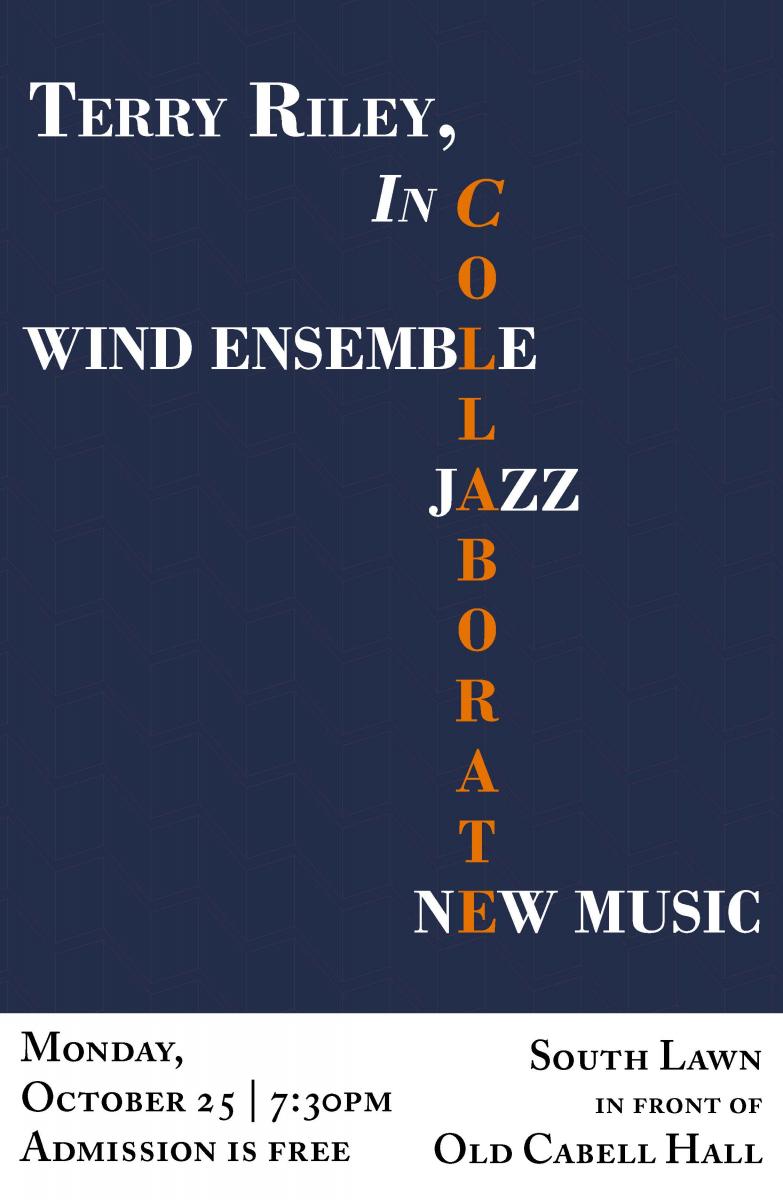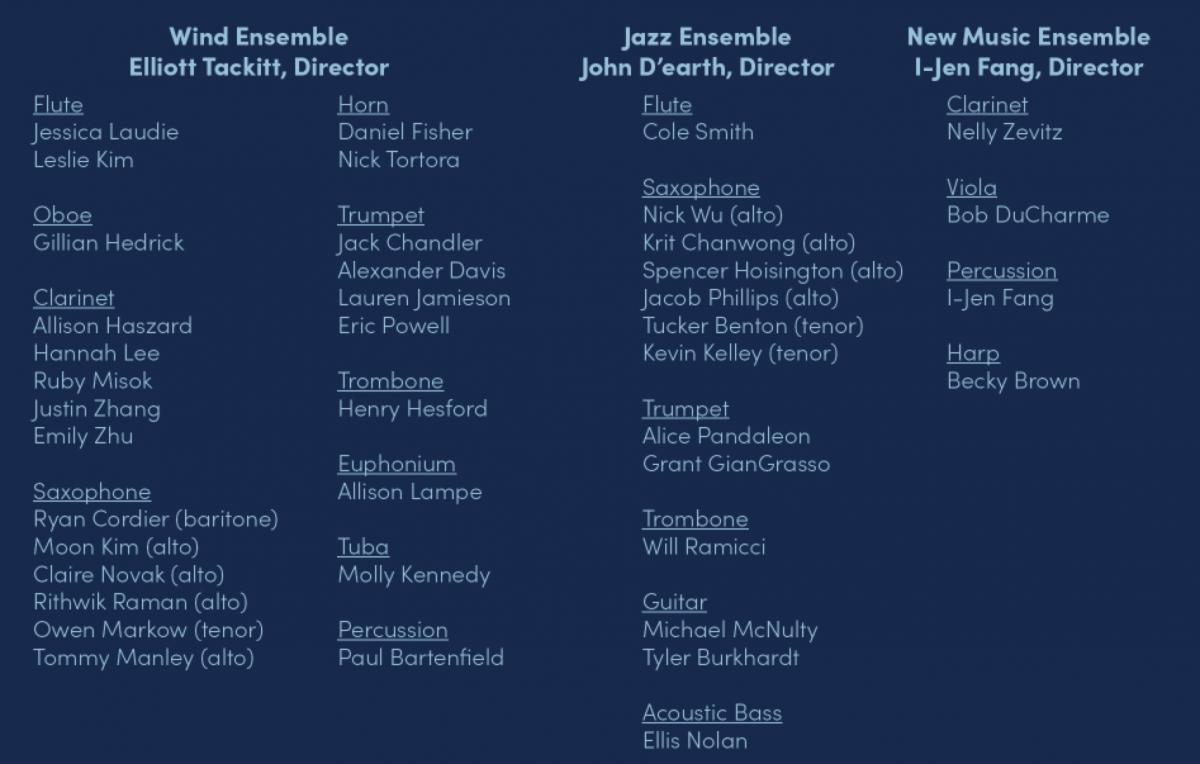In C, Terry Riley’s minimalistic masterpiece on 11/1/21
 Postponed until 11/1/21 at 7:30pm- The UVA Wind Ensemble, New Music Ensemble, and Jazz Ensemble join together for a one-of-a-kind collaborative performance of Terry Riley’s minimalistic masterpiece, In C (1964). Performed near Old Cabell Hall beginning at 7:30 pm on Monday, November 1, each ensemble member will be randomly positioned throughout the south lawn area. Passersby and attendees are invited to walk among the performers to create their own listening experience, or to enjoy listening from one of the chairs under the OCH tent. All are encouraged to “snap” the QR code that will be on each performer’s stand and on A-frame signage to learn more about Terry Riley, In C, and the performers. (or just scroll down on this page)
Postponed until 11/1/21 at 7:30pm- The UVA Wind Ensemble, New Music Ensemble, and Jazz Ensemble join together for a one-of-a-kind collaborative performance of Terry Riley’s minimalistic masterpiece, In C (1964). Performed near Old Cabell Hall beginning at 7:30 pm on Monday, November 1, each ensemble member will be randomly positioned throughout the south lawn area. Passersby and attendees are invited to walk among the performers to create their own listening experience, or to enjoy listening from one of the chairs under the OCH tent. All are encouraged to “snap” the QR code that will be on each performer’s stand and on A-frame signage to learn more about Terry Riley, In C, and the performers. (or just scroll down on this page)
The South Lawn, otherwise known as Homer Flat, is located in front of Old Cabell Hall on Central Grounds. It is on the opposite side of the Lawn of the Rotunda.
The South Lawn is located in front of Building 31 on this map
All events are subject to change.
Program Notes:
Terry Riley (b. 1935, Colfax, CA) is an American composer and performer. Riley studied piano and music theory at Shasta College (1954–55) and studied music composition at San Francisco State University (BA 1957), while continuing his piano studies at the San Francisco Conservatory (1955–57). He completed his MA at the University of California, Berkeley in 1961. Riley has had a variety of musical interests throughout his prolific career. A virtuosic pianist, he studied ragtime piano with Wally Rose, studied with Kirana vocal master Pandit Pran Nath for over 25 years, and has written works which evidence an influence by Stockhausen’s serial technique.
Riley met La Monte Young at Berkeley, who was an important influence on Riley’s work in the early and mid-1960s. Today, Young and Riley are recognized as two leading American minimalist composers of the mid-20th century. Riley’s String Quartet (1960) reflects Young’s influence by way of long spans of sustained single pitches as well as silences, aecting the listener’s sense of time and traditional harmonic expectations. His quartet is highly contrasted by his String Trio (1961), which features repetitive short phrases and seemingly eschews tonality. Together, Young and Riley provided a sound world for experimental dance works by Ann Halbrin, while Riley continued his musical experimentations, which included new tape technologies, echo eects, and live loop playback.
Following two years of intense study in Spain and Paris, Riley returned to San Francisco. Shortly after returning to the United States, Riley wrote In C (1964), arguably his best-known work. Edward Strickland contributed the following to Grove Music Online about In C:
The score consists of 53 phrases, or modules, each player freely repeating each phrase as many times as desired before proceeding to the next. As a consequence, unpredictable layering of the same and successive motifs occurs, creating elaborate canonic textures and polyrhythms…In C defined the minimalist style of modular repetition and was the first work to bring minimalism into the mainstream culture, aided by Alfred Frankenstein’s highly avorable review in the San Francisco Chronicle of the première at the Tape Music Center on November 8, 1964. Steve Reich, Jon Gibson, Pauline Oliveros, and Morton Subotnick were among the players in the first performance of In C.
The following performing directions for In C were provided by Terry Riley himself:
All performers play from the same page of 53 melodic patterns played in sequence. Any number of any kind of instruments can play…Patterns are to be played consecutively with each performer having the freedom to determine how many times he or she will repeat each pattern before moving on to the next. There is no fixed rule as to the number of repetitions a pattern may have, however, since performances normally average between 45 minutes and an hour and a half, it can be assumed that one would repeat each pattern from somewhere between 45 seconds and minute and a half.
It is very important that performers listen very carefully to one another, and this means occasionally to drop out and listen. As an ensemble, it is very desirable to play very softly as well as very loudly and to try to diminuendo and crescendo together.
Each pattern can be played in unison or canonically in any alignment with itself or with its neighboring patterns. One of the joys of IN C is the interaction of the players in polyrhythmic combinations that spontaneously arise between patterns. Some quite fantastic shapes will arise and disintegrate as the group moves through the piece when it is properly played.
It is important not to hurry from pattern to pattern but to stay on a pattern long enough to interlock with other patterns being played. As the performance progresses, performers should stay within 2 or 3 patterns of each other. It is important not to race too far ahead or lag too far behind.
The ensemble can be aided by the means of an eighth note pulse played on the high C’s of the piano or on a mallet instrument. It is also possible to use improvised percussion in strict rhythm (in our case, we are using an electronically created metronome), if it is carefully done and doesn’t overpower the ensemble. All performers must play strictly in rhythm, and it is essential that everyone play each pattern carefully.
It is important to think of patterns periodically so that when you are resting you are conscious of the larger periodic composite accents that are sounding, and when you re-enter, you are aware of what eect your entrance will have on the music’s flow.
Program note compiled by Elliott Tackitt
Roster:

